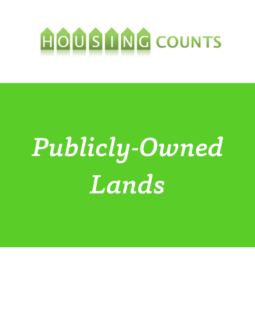Make Publicly-Owned Land Available for Affordable Workforce Homes
In most communities, public agencies control significant amounts of land. Public agencies may acquire land for the specific purpose of facilitating new development. Additionally, publicly-owned land can include both undeveloped and developed parcels, such as schools, public hospitals, parking lots, fire and police stations, and agency headquarters. Communities may also have surplus properties which are no longer needed to serve public purposes. These include examples such as closed fire stations, libraries and schools. Others public land may be properties that are underutilized and could accommodate higher-densities.
Publicly-owned land and buildings can be critical resources in diversifying the housing stock and providing homes affordable to various income levels that do not currently exist. Opportunities to use publicly-owned land and buildings to diversify the housing stock include making vacant land available for housing development, building at higher density on lower-density sites, and adding residential space on top of existing structures such as parking garages and fire stations. By finding affordable housing opportunities on publicly-owned land, localities can lead by example and demonstrate their commitment to increasing the supply of housing choices at a lower cost than might otherwise be incurred.
What about tax-delinquent properties?
The reuse of tax-delinquent properties involves substantially different processes and policies than the use of other publicly-owned land. Acquiring and reusing tax-delinquent properties is, therefore, the focus of its own section in the Minnesota toolbox.
What problems are solved by making publicly-owned land available for affordable homes?
In high-cost areas, affordably-priced land is in short supply. By offering publicly-owned land at no cost, or at a reduced cost, to developers of affordable homes, communities can bring down the land costs and make affordable housing possible in places that might otherwise be cost prohibitive.
Publicly-owned land also offers a valuable opportunity for local governments to take an active role in shaping their communities through direct control of land-use decisions. For example, a community could use publicly-owned land to demonstrate the feasibility of higher-density, mixed-income, or mixed-use developments. This is a particularly attractive way to demonstrate developments that contain a strong affordability component. Additionally, when the city conveys land using a Request for Proposals (RFP) process, it can both select a developer and play a major role in determining exactly what is built, especially in terms of design, households served, and affordability. One good example is Woodbury’s City Walk development in which the city acquired a 2.2 acre parcel from the developer of a large site and selected a developer for an affordable component of the project using an RFP process.
Where are these policies most applicable?
Undeveloped land and unused public buildings can be extremely hard to find within developed communities and urban areas. These areas are most in need of higher densities and connected development patterns. The use of existing public land or public land acquisition are critical tools in the creation of these new developments. In locations where vacant land for new development is hard to come by, former manufacturing buildings, industrial sites, and recently foreclosed properties have become viable options to provide housing that is affordable to lower income people. Publicly-owned land and buildings are important resource for stimulating community development, saving outdated community assets through adaptive reuse while diversifying the housing stock.
The Land Bank – Twin Cities responds quickly and effectively opportunities on the real estate market through its diversity of services which include acquiring, financing, land banking properties.
More resources on public lands
Take a look at Prioritizing Public Lands: Best Practices & Model Ordinances and this outline of the public lands opportunity.
